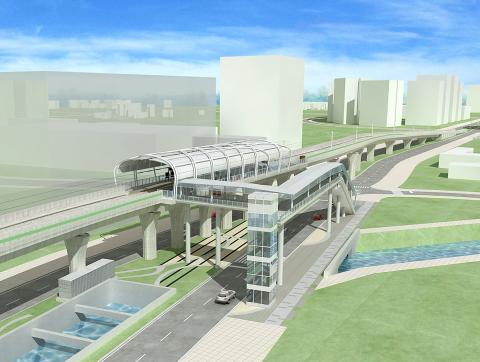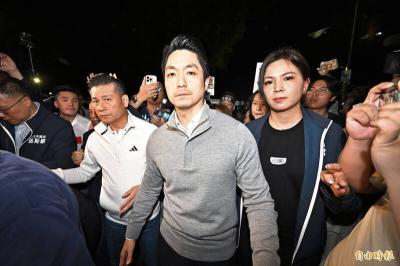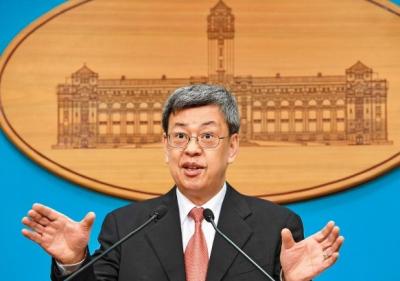Construction of the first phase of the light rail system in New Taipei City’s Tamsui District (淡水) is 30.95 percent complete, the city’s Department of Rapid Transit Systems announced on Friday.
Work began on the 9.52km first phase of the project in September 2014 and is scheduled to be completed by the end of 2018.
The department also announced the Chinese names of the 14 stops to be built in the current phase of the project, but the English names have yet to be decided.

Photo: CNA, provided by the New Taipei City Government
The tram system’s first phase encompasses 14 stops on two tram lines — the Lushan (Green Mountain) Line, which has 11 stops, and the Lanhai (Blue Seaside) Line, which has three stops.
The Lushan Line starts from the Hongshulin MRT station and runs along Zhongzheng E Road, Provincial Highway No. 2, Binhai Road and Shalun Road, and ends near the Danhai New Town project.
The Lanhai Line shares the 1.21km section of track and three stops along Shalun Road with the Lushan Line before going in the other direction on Binhai Road and ending at Fisherman’s Wharf.
The first phase is being built by a consortium led by the government-invested China Steel Corp.
The department said it plans to unveil the carriages to be used on the tram lines, which are being built locally by Taiwan Rolling Stock Co, by the end of this year.
The total budget for the Danhai light-rail system, including a second phase to extend the Lanhai Line along the Tamsui River between Fisherman’s Wharf and the Tamsui metro station, is NT$15.3 billion (US$474.24 million), according to the department.
The tram lines are part of the development of the 1,748.7 hectare Danhai New Town, which was launched in 1992 and hopes to attract a population of 300,000 by 2036.
As of last month, the total population of Tamsui District was 163,141, according to city government statistics.

Several Chinese Nationalist Party (KMT) officials including Chairman Eric Chu (朱立倫) are to be summoned for questioning and then transferred to prosecutors for holding an illegal assembly in Taipei last night, the Taipei Police said today. Chu and two others hosted an illegal assembly and are to be requested to explain their actions, the Taipei City Police Department's Zhongzheng (中正) First Precinct said, referring to a protest held after Huang Lu Chin-ju (黃呂錦茹), KMT Taipei's chapter director, and several other KMT staffers were questioned for alleged signature forgery in recall petitions against Democratic Progressive Party (DPP) legislators. Taipei prosecutors had filed

Taiwan would welcome the return of Honduras as a diplomatic ally if its next president decides to make such a move, Minister of Foreign Affairs Lin Chia-lung (林佳龍) said yesterday. “Of course, we would welcome Honduras if they want to restore diplomatic ties with Taiwan after their elections,” Lin said at a meeting of the legislature’s Foreign Affairs and National Defense Committee, when asked to comment on statements made by two of the three Honduran presidential candidates during the presidential campaign in the Central American country. Taiwan is paying close attention to the region as a whole in the wake of a

NEW WORLD: Taiwan is pursuing innovative approaches to international relations through economics, trade and values-based diplomacy, the foreign minister said Taiwan would implement a “three-chain strategy” that promotes democratic values in response to US tariffs, Minister of Foreign Affairs Lin Chia-lung (林佳龍) said. Taiwan would aim to create a “global democratic value chain,” seek to capitalize on its position within the first island chain and promote a “non-red supply chain,” Lin was quoted as saying in the ministry’s written report to the Legislative Yuan submitted ahead of the legislature’s Foreign Affairs and National Defense Committee meeting slated for today. The Ministry would also uphold a spirit of mutual beneficial collaboration, maintaining close communication and consultations with Washington to show that Taiwan-US cooperation

President William Lai (賴清德) has appointed former vice president Chen Chien-jen (陳建仁) to attend the late Pope Francis’ funeral at the Vatican City on Saturday on his behalf, the Ministry of Foreign Affairs said today. The Holy See announced Francis’ funeral would take place on Saturday at 10am in St Peter’s Square. The ministry expressed condolences over Francis’ passing and said that Chen would represent Taiwan at the funeral and offer condolences in person. Taiwan and the Vatican have a long-standing and close diplomatic relationship, the ministry said. Both sides agreed to have Chen represent Taiwan at the funeral, given his Catholic identity and